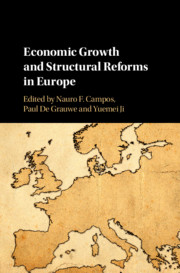Book contents
- Economic Growth and Structural Reforms in Europe
- Economic Growth and Structural Reforms in Europe
- Copyright page
- Contents
- Figures
- Tables
- Contributors
- Introduction
- Part I Economic Growth and Structural Reforms in Europe
- Part II Macroeconomic Implications of Reforms
- Part III Case Studies
- 10 Structural Reforms in Europe
- 11 Fiscal Consolidation and Inequality
- 12 How Openness to Trade Rescued the Irish Economy
- 13 Goulash Labour Market Structural Reforms
- Conclusions
- Index
- References
12 - How Openness to Trade Rescued the Irish Economy
from Part III - Case Studies
Published online by Cambridge University Press: 31 March 2020
- Economic Growth and Structural Reforms in Europe
- Economic Growth and Structural Reforms in Europe
- Copyright page
- Contents
- Figures
- Tables
- Contributors
- Introduction
- Part I Economic Growth and Structural Reforms in Europe
- Part II Macroeconomic Implications of Reforms
- Part III Case Studies
- 10 Structural Reforms in Europe
- 11 Fiscal Consolidation and Inequality
- 12 How Openness to Trade Rescued the Irish Economy
- 13 Goulash Labour Market Structural Reforms
- Conclusions
- Index
- References
Summary
In this chapter, we examine the performance of the Irish economy over the period 2008 to 2014. In particular, we examine whether the recovery observed was due to the successful adoption of structural reforms in labour and product markets or whether the improved performance was due to a rebalancing of the Irish economy, post-2008, away from the disproportionate influence of the construction (nontradable) sector and back to the more productive tradable sector. Prior to 2007, Ireland had seen the emergence of a significant, property-related credit boom that resulted in the Irish economy being increasingly influenced by the nontradable sector. This was in sharp contrast to the earlier period of the Celtic tiger, which had mainly relied on export-orientated growth. We use a small open economy DSGE model with a tradable and a nontradable sector to examine this issue. Our results suggest that the financial crisis acted as a rebalancing mechanism for the Irish economy, with the tradable sector contracting less and recovering quicker than the nontradable sector. Our model-based simulations indicate that the Irish recovery is mostly export driven, with structural reforms playing a very minor role in stimulating growth in the immediate period after the crisis.
- Type
- Chapter
- Information
- Economic Growth and Structural Reforms in Europe , pp. 377 - 406Publisher: Cambridge University PressPrint publication year: 2020
References
- 3
- Cited by



